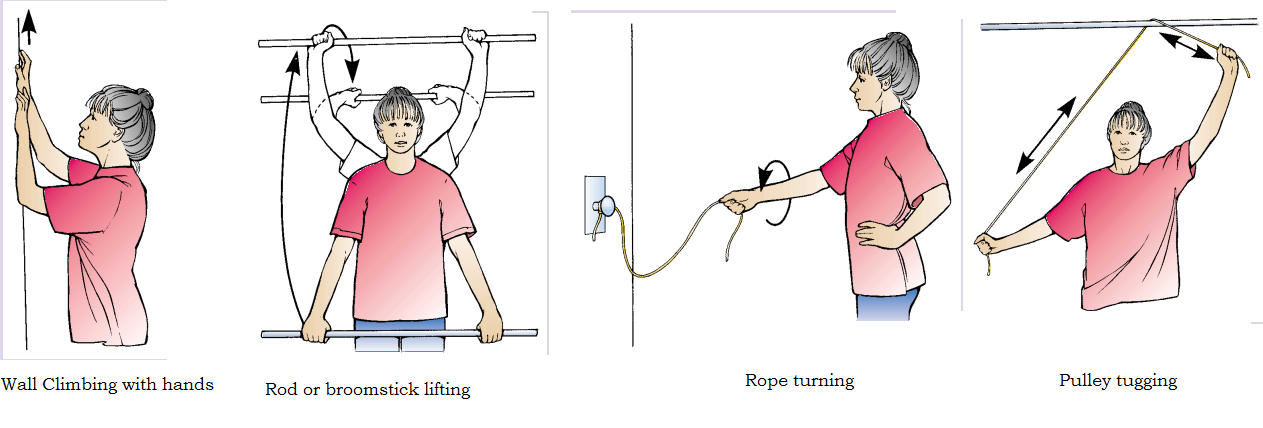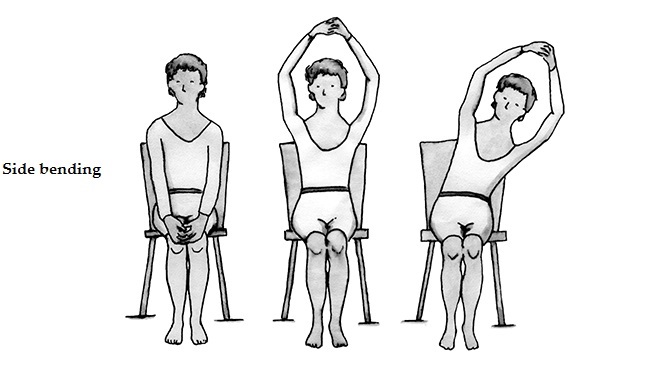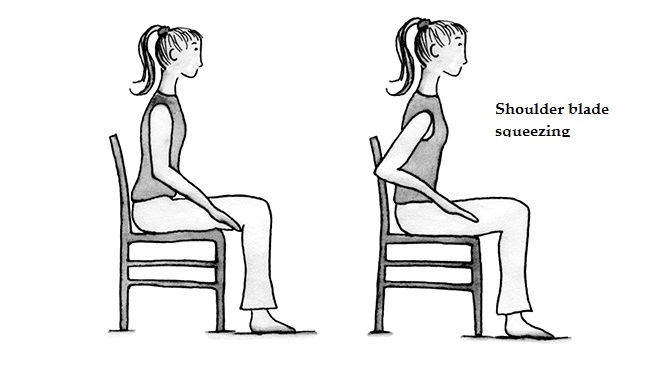Postmastectomy Exercises
Introduction
Exercises to be done by patients who undergo any major surgery of the breast to get the arm and shoulder move well again and to reduce the side effects of the surgery.
Physiotherapist or occupational therapist can help
Some exercises should not be done until drains and sutures are removed
Some exercises can be done soon after surgery
Early in the postoperative period
The week after surgery
1. Use the arm for combing hair, bathe, get dressed and eat
2. Lie down and raise the arm above the level of heart for 45 mts. Do this 2 or 3 times a day - reduces swelling - Elevate the arm on pillows while at rest
3. Close and open the hands while raised
4. Deep breathing - 6 times a day
Lie down on back - breathe in deeply and slowly and expand the chest and abdomen and then breathe out.
Do not sleep on your affected arm or lie on that side
No bouncing or jerking movts during exercises
Only stretching of the scar and wound allowed with very minimal pain or no pain.
Take deep breaths, in and out, as the exercises are done
Later on :
Shoulder Stretching
Chest wall stretching
Side bending
Shoulder blade squeezing
Shoulder blade stretching
Rope turning
Rod lifting
Wall climbing
The week after surgery
The tips and exercises listed below should be done for the first 3 to 7 days after surgery. Do not do them until you get the OK from your doctor.
Use your affected arm (on the side where your surgery was) as you normally would when you comb your hair, bathe, get dressed, and eat.
Lie down and raise your affected arm above the level of your heart for 45 minutes. Do this 2 or 3 times a day. Put your arm on pillows so that your hand is higher than your wrist and your elbow is a little higher than your shoulder. This will help decrease the swelling that may happen after surgery.
Exercise your affected arm while itís raised above the level of your heart by opening and closing your hand 15 to 25 times. Next, bend and straighten your elbow. Repeat this 3 to 4 times a day. This exercise helps reduce swelling by pumping lymph fluid out of your arm.
Practice deep breathing exercises (using your diaphragm) at least 6 times a day. Lie down on your back and take a slow, deep breath. Breathe in as much air as you can while trying to expand your chest and abdomen (push your belly button away from your spine). Relax and breathe out. Repeat this 4 or 5 times. This exercise will help maintain normal movement of your chest, making it easier for your lungs to work. Do deep breathing exercises often.
Do not sleep on your affected arm or lie on that side.
General guidelines for these exercises
The exercises described here can be done as soon as your doctor says it's OK. Theyíre usually started a week or more after surgery. Be sure to talk to your doctor before trying any of them. Here are some things to keep in mind after breast surgery:
You will feel some tightness in your chest and armpit after surgery. This is normal, and the tightness will decrease as you do your exercises.
Many women have burning, tingling, numbness, or soreness on the back of the arm and/or on the chest wall. This is because the surgery can irritate some of your nerves. These feelings might increase a few weeks after surgery. But keep doing your exercises unless you notice unusual swelling or tenderness. (If this happens, let your doctor know about it right away.) Sometimes rubbing or stroking the area with your hand or a soft cloth can help make the area less sensitive.
It may be helpful to do the exercises after a warm shower when muscles are warm and relaxed.
Wear comfortable, loose clothing when doing the exercises.
Do the exercises slowly until you feel a gentle stretch. Hold each stretch at the end of the motion and slowly count to 5. Itís normal to feel some pulling as you stretch the skin and muscles that have been shortened because of the surgery. Do not bounce or make any jerky movements when doing any of the exercises. You should not feel pain as you do them, only gentle stretching.
Do each exercise 5 to 7 times. Try to do each exercise correctly. If you have trouble with the exercises, talk to your doctor. You may need to be referred to a physical or occupational therapist.
Do the exercises twice a day until you get back your normal flexibility.
Be sure to take deep breaths, in and out, as you do each exercise.
The exercises are set up so that you start them lying down, move to sitting, and finish them standing up.
Here are some of the more common exercises that women do after breast surgery. Talk to your doctor or therapist about which of these are right for you and when you should start doing them. Do not start any of these exercises without talking to your doctor first.
Wand exercise
Wand Exercise
This exercise helps increase your ability to move your shoulders forward. You will need a broom handle, yardstick, or other stick-like object to use as the wand in this exercise. Do these exercises on a bed or the floor. Lie on your back with your knees bent and your feet flat.
Hold the wand across your belly in both hands with your palms facing up.
Lift the wand up over your head as far as you can. Use your unaffected arm to help lift the wand until you feel a stretch in your affected arm.
Hold for 5 seconds.
Lower arms and repeat 5 to 7 times.
Elbow winging
Elbow Winging
This exercise helps increase the movement in the front of your chest and shoulder. It may take many weeks of regular exercise before your elbows will get close to the bed or floor. Do these exercises on a bed or the floor. Lie on your back with your knees bent and your feet flat.
Clasp your hands behind your neck with your elbows pointing toward the ceiling.
Move your elbows apart and down toward the bed or floor.
Repeat 5 to 7 times.
Shoulder blade stretch
Shoulder Blade Stretch
This exercise helps increase your shoulder blade movement.
Sit in a chair very close to a table with your back against the back of the chair.
Place the unaffected arm on the table with your elbow bent and palm down. Do not move this arm during the exercise.
Place the affected arm on the table, palm down, with your elbow straight.
Without moving your trunk, slide the affected arm forward, toward the opposite side of the table. You should feel your shoulder blade move as you do this.
Relax your arm and repeat 5 to 7 times.
Shoulder blade squeeze
Shoulder Blade Squeeze
This exercise also helps increase shoulder blade movement.
Sit in a chair in front of a mirror. Face straight ahead. Do not rest against the back of the chair.
Your arms should be at your sides with your elbows bent.
Squeeze your shoulder blades together, bringing your elbows behind you. Keep your shoulders level as you do this. Do not lift your shoulders up toward your ears.
Return to the starting position and repeat 5 to 7 times.
Side bends
Side Bends
This exercise helps increase movement of your trunk and body.
Sit in a chair and clasp your hands together in front of you. Lift your arms slowly over your head, straightening your arms.
When your arms are over your head, bend your trunk to the right keeping your arms overhead.
Return to the starting position and bend to the left.
Repeat 5 to 7 times.
Chest wall stretch
Chest Wall Stretch
This exercise helps stretch your chest.
Stand facing a corner with your toes about 8 to 10 inches from the corner.
Bend your elbows and put your forearms on the wall, one on each side of the corner. Your elbows should be as close to shoulder height as possible.
Keep your arms and feet in place and move your chest toward the corner. You will feel a stretch across your chest and shoulders.
Return to the starting position and repeat 5 to 7 times.
The picture shows stretching both sides at the same time, but you may find it more comfortable to stretch one arm at a time.
Be sure you keep your shoulders dropped far away from your ears as you do this stretch.
Shoulder stretch
Shoulder Stretch
This exercise helps increase your mobility in your shoulder.
Stand facing the wall with your toes about 8 to 10 inches from the wall.
Put your hands on the wall. Use your fingers to "climb the wall," reaching as high as you can until you feel a stretch.
Return to the starting position and repeat 5 to 7 times.
The picture shows both arms going up at the same time, but you might find it easier to raise one arm at a time.
Be sure you keep your shoulders dropped far away from your ears as you raise your arms.
Things to keep in mind after breast surgery
Start exercising slowly and increase as you are able. Stop exercising and talk to your doctor right away if you:
Get weaker, start losing your balance, or start falling
Have pain that gets worse
Have new heaviness, aching, tightness, or other strange sensations in your arm
Have unusual swelling or swelling gets worse
Have headaches, dizziness, blurred vision, new numbness, or tingling in your arms or chest
Itís important to exercise to keep your muscles working as well as possible, but itís also important to be safe. Talk with your doctor about the right kind of exercises for your condition, and then set goals for increasing your level of physical activity.
Other kinds of exercise
Exercise to help improve aerobic (heart-lung) capacity is also important for women who have had breast cancer. Thereís evidence that fitness and weight loss may even help lower the risk that some types of cancer will come back after treatment. Ask your doctor about fitness exercises during and after breast cancer treatment.
Other exercises are designed to help reduce your risk of lymphedema, or swelling in the arm on the side where you had surgery. The exercises shown here are mainly designed to help regain range of motion (flexibility) of the arm and shoulder. Ask your doctor about your lymphedema risk and if you should use exercises to help reduce that risk.
Strengthening exercises are now recommended as part of regular exercise programs to improve health. These are not started until 4 to 6 weeks after surgery, and must be tailored to your general health, medical condition, and fitness. Strength building starts by using small hand weights, and is increased slowly over time. Again, this is best addressed with your doctor or physical therapist. Itís probably best to start a strengthening program in a supervised setting with a cancer exercise trainer or physical therapist to be sure youíre doing the exercises properly.
This information was developed with assistance from the Oncology Section of the American Physical Therapy Association.
Written by





